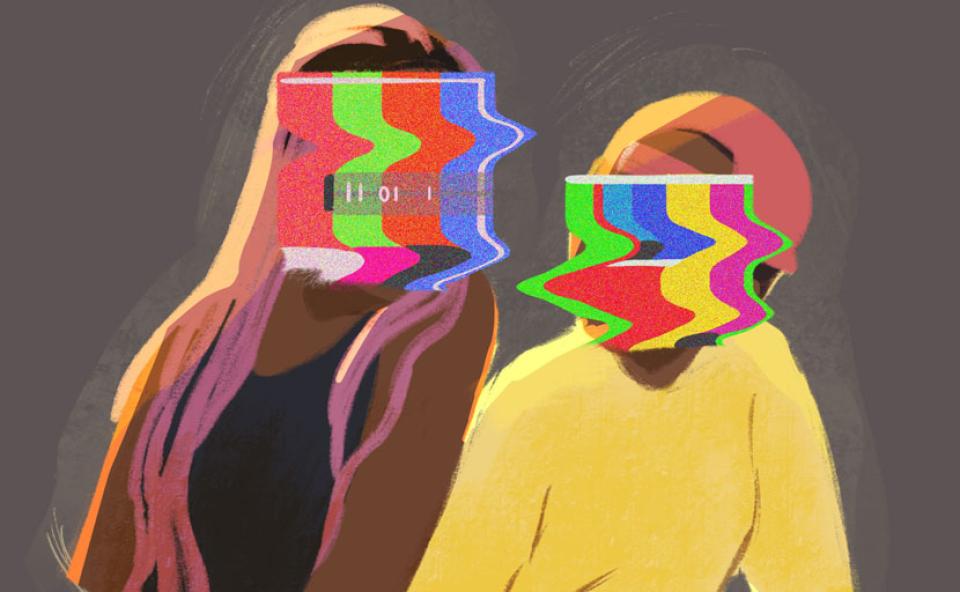
Image description: Illustration of two people sitting side by side, faces covered by tv static. Image credit: Nabigal-Nayagam Haider Ali
A brief observation of the analytical frameworks used by a great number of Kenyan social media users around the controversy surrounding the release of the Kenyan film Rafiki may make you more familiar with the rubrics of “artistic freedom” and “freedom of speech” than those of “queerness” and “precariousness” ( here “queerness” accounts for those Kenyans who live outside of gender and sexuality norms). These uneven uptakes were on full display on September 21, 2018 the day that High Court Justice Wilfrida Okwany ruled that the film previously banned by the Kenya Film Classification Board for “promoting lesbianism,” could now be viewed by Kenyans in public spaces for the duration of a week. Justice Okwany stated, “I am not convinced that Kenya is such a weak society that its moral foundation will be shaken by seeing such a film.”[i] In celebration of the ruling, @wanuri the film’s director tweeted, “(The Kenyan) constitution is STRONG! Give thanks to freedom of expression,” even as the legality of same-sex sex remained in flux and the lives of many queer Kenyans continued to remain at the unsaid mercy of their anti-queer neighbours, families, friends, and government under the same legal regime. Yet Kahiu was not alone in making this analysis, as multiple Kenyan social media users made similar analyses.[ii] In the wake of a controversy fueled by institutional anti-queerness, queer vulnerability was folded into a disremembered, uncited asterisk, while privacy and speech rights were expanded to the level of the thematic, occupying a kind of resonant spectacularity in Kenyan Twitter discourse.
"I am not convinced that Kenya is such a weak society that its moral foundation will be shaken by seeing such a film." -- Justice Wilfrida Okwany
Here, the constitution was imagined as capable of protecting the expression of a hypothetical, filmic queer intimacy, but not the banal kind – the type practised in packed rooms hidden away in unnavigable locations or floating around on our Twitter timelines. Kenyans on Twitter had mobilized their collective political clout to generate analyses of the state’s failure to adhere to the human rights criteria of “freedom of expression” and “freedom of speech,” which were imagined as having the ability to safeguard artistic exchange, often even failing to mention that Kenyan queer people were the ban’s primary victims. As such, what was largely erased from cisgender heterosexual discourse surrounding the film, what I will call “straight digital discourse,” was an analysis of the spectre of queer precarity – the ways in which this ban and its subsequent unbanning were rooted in the same logics of coloniality and heteronormativity that the Kenyan state had always used to police everyday queer life.
A few months later, on October 31 2018, Paul Makonda, Dar Es Salaam’s regional commissioner, announced that he would be putting together an anti-gay surveillance squad which would be tasked with hunting down and imprisoning gay Tanzanians. Critically, the committee indicated that it would be mining social media data and networks in order to identify queer Tanzanians.[iii] This directive was issued even as social media platforms such as Twitter and Facebook had been heralded as spaces that provided their users with the ability to express themselves beyond constraints on freedom of speech created by states the world over, particularly in the aftermath of the so-called Arab Spring.[iv] In citing the motivations for his directive, Makonda claimed that he had information that many queer Tanzanians were active on social media, specifically he said that they “boast[ed] on social networks.”[v] Where Twitter had functioned as a space on which queer Tanzanians could simply be “political and loud and take up space,” as one queer social media user put it, it was appropriated as a site of policing and state terror. Here, the freedom of expression that was supposed to be engrained into Twitter’s digital infrastructures was rendered mute, and at the same time resituated as lethally potent, such that to speak whilst queer could lead to one’s arrest or worse.
These two digital moments are not only related due to their geopolitical proximity but due to the ways in which they present digital interventions that both neglect queer narratives and collapse upon encountering queer precariousness. Whilst freedom of expression becomes the primary analytic in social media discourses concerning the effects of the Kenyan state’s film ban, queer Tanzanians are muted by the Tanzanian state’s anti-queer manhunt on a platform frequently described as “free” and “vibrant.” As such, if freedom of speech is what is recuperated in the unbanning of Rafiki, it remains in crisis in Tanzania’s anti-queer manhunt, where queer bodies are directly threatened. At the cusp of these two crises, it becomes clear that the gesture of situating freedom of expression as the primary casualty of state surveillance and control only makes sense in the context of manoeuvres that extract queerness from digital dialogues about state anti-queerness.
This extraction of queerness occurs in digital time and space, where virality is often more valued than radical imaginative work
This extraction of queerness occurs in digital time and space, where virality is often more valued than radical imaginative work – where speed often trumps care. Under these conditions, the language of human rights and their substance are resituated as more legible and accessible digital remedies for queer vulnerability, even as queer people remain illegible and under attack offline. Here, within straight digital discourse, human rights are imagined as capable of both enabling queer stories to be told unperturbed by government censorship, and facilitating intimate and frivolous intimacy despite their long-chronicled inability to generate more humane realities. This untethering generates a detached digital theoretical space where the fraught histories of human rights and their limited possibilities are disremembered. It is this enduring fissure, this tendency to imagine and fetishize digital space as detached and its freedoms as possible in spite of offline despotism, that not only propagates the erasure of queer narratives, but also the production of a kind of online queer defensiveness.
If freedom of speech is what is recuperated in the unbanning of Rafiki, it remains in crisis in Tanzania’s anti-queer manhunt, where queer bodies are directly threatened.
In Reimagining Black Feminism: after intersectionality, Black feminist academic Jennifer Nash uses the affective concept of “defensiveness” to think through Black feminists’ affective and intellectual attachments to intersectionality, a framework appropriated by the academy and other racist institutions, and subsequently “guarded and protected through the requisite black feminist vigilance, care, and “stewardship””[vi]. Ultimately, for Nash, defensiveness is a space marked by “feelings of ownership and territoriality, and by loss and grief.”[vii] As such, here I use defensiveness to describe what transpires as a result of incomplete narratives (Rafiki) or “straight silence” (anti-queer manhunt) in the face of anti-queer government policy, particularly when much care and nuance is generated in discussing crises affecting non-queer individuals.
Here I want to think of “holding on,” what Nash theorizes as the practice of defensiveness, as a queer practice of both embrace and retention where queer people earnestly safeguard queer meaning making and narratives for purposes of maintaining community. However, I also want to think of “holding on” as “clutching,” “containing” and “policing” – those taxing queer dispositions that emerge when the risk of erasure eclipses that of possibility. In both cases, to “hold on” is to fight for digital queer memory, for digital queer accounts, and to simultaneously lose space to feel fear, community and worry.
As free speech rights-based analyses proliferated across Twitters networks, queer Kenyans were forced to reimagine these interventions as rooted in their own erasure. One queer social media user wrote, “It was never about the Oscar or freedom of creativity/expression. It was always about queer representation, queer rights, queer humanities.” Similarly, in the aftermath of Makonda’s announcement of the anti-queer manhunt, queer Tanzanian social media users critiqued cisgender, heterosexual social media users, who upon failing to comment on Makonda’s directive had forced queer Tanzanians to contest the government’s inhumane policies alone.
Here defensiveness was performed against the consumptive logics that marked cisgender, heterosexual Tanzanians’ engagements with queer Tanzania. Within this dynamic, straight Tanzanians could verbally claim allyship but would “not even share an article,” as another queer social media user wrote in a tweet. In both cases, queer people were “holding on” or “clutching,” “containing” and “policing” digital straight discourse, instead of working through the complicated and daunting realities of living queerly under anti-queer conditions. What was lost when straight digital discourses fetishized “freedom of expression” were queer accounts of their own vulnerability in a moment of crisis.
What was lost when straight digital discourses fetishized “freedom of expression” were queer accounts of their own vulnerability in a moment of crisis.
***
When the viral moment has dissipated, when queer crisis is condensed back into everyday queer terror – in these banal moments, what might it look like to re-centre queer accounts in digital discourses on queer vulnerability? What might it look like to aspire toward visions of queer wellbeing that are not tethered to statist rubrics such as human rights? Here, “holding on” might be transformed from solely a practice of policing into a practice of “holding on” – those critical, communal practices of “embrace” and “retention.” Here, discourses that situate the same states and institutions that generate queer vulnerability as the primary benefactors of queer wellbeing or “rights,” might be reconsidered. But more critically, “holding on,” both “embrace” and “clutching” might be intertwined in order to generate alternative worlds for ourselves– ones deeply engrained in the work of community making, radical organizing, and accountability. In “holding on,” we might generate more expansive queer accounts that enable us to survive both queer spectacle and the queer everyday.
In “holding on,” we might generate more expansive queer accounts that enable us to survive both queer spectacle and the queer everyday .
[i] Kimuyu, Hilary, “Film lovers In Kenya Can now watch lesbian movie ‘Rafiki’,” Nairobi News, September 21, 2018, https://nairobinews.nation.co.ke/chillax/film-lovers-kenya-watch-rafiki.
[ii] Griffin, Tamera, “They Banned Her Film Because It Featured LGBT Characters. So She Took Them To Court — And Won,” Buzzfeed, September 14, 2018, https://www.buzzfeednews.com/article/tamerragriffin/kenya-rafiki-film-b….
[iii] Romo, Vanessa, “Tanzanian Leader Launches Anti-Gay Crackdown, Expects to Round Up Hundreds,” NPR, November 2, 2018,
[iv] See Paulo Gerbaudo’s “Tweets and the Streets.”
[v] AFP, “Dar es Salaam regional commissioner launches anti-gay clampdown,” The East African, October 30, 2018, https://www.theeastafrican.co.ke/news/ea/Tanzania-city-governor-launche….
[vi] Nash, Jennifer. Reimagining Black Feminism: after Intersectionality. (Durham: Duke University Press, 2019), 3.
[vii] Nash, Jennifer, 32.
- 5824 views






Add new comment